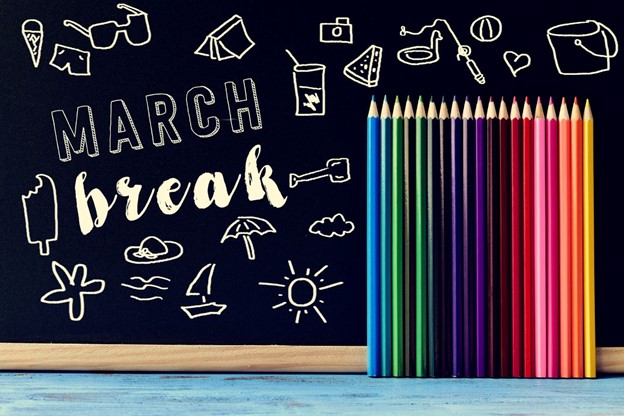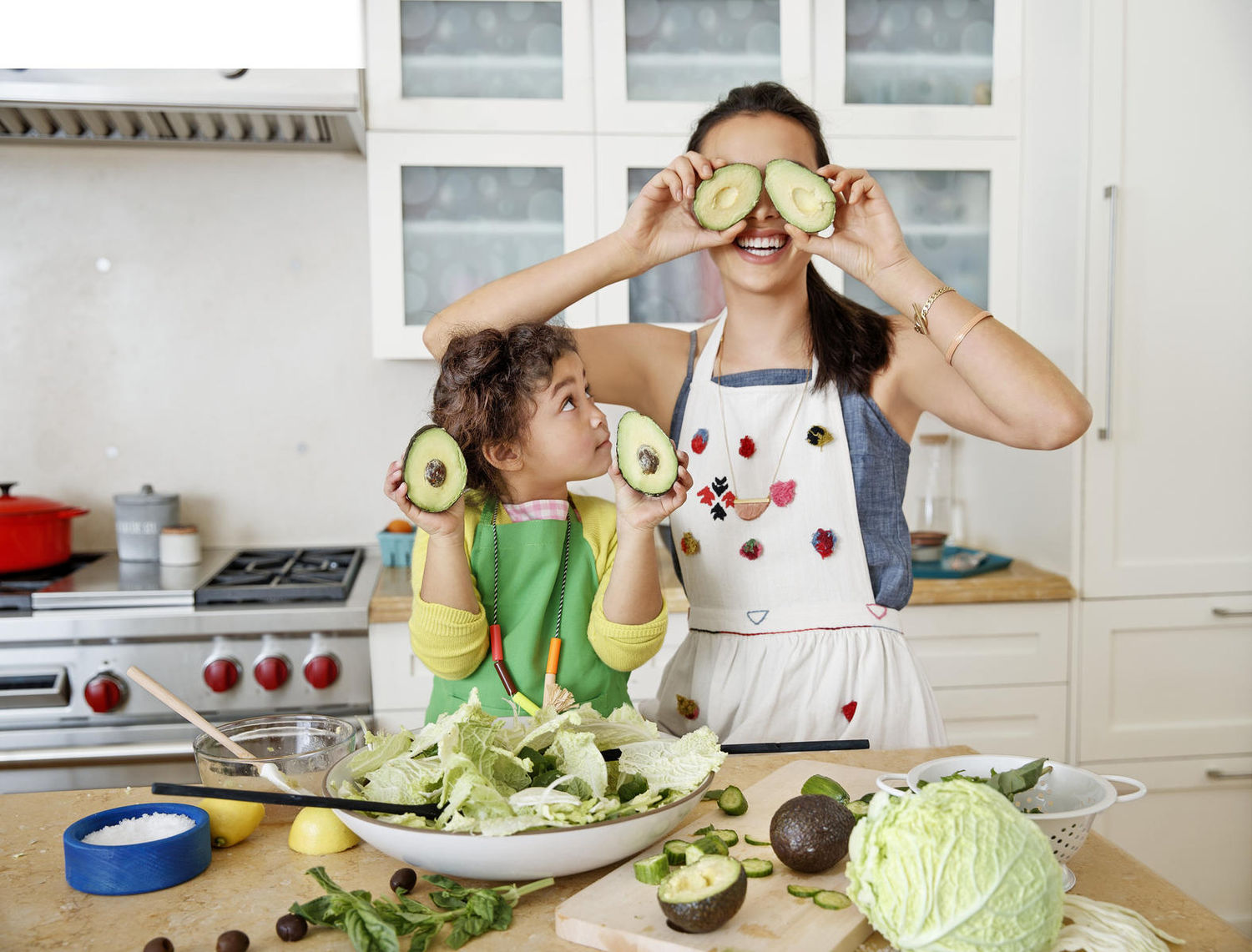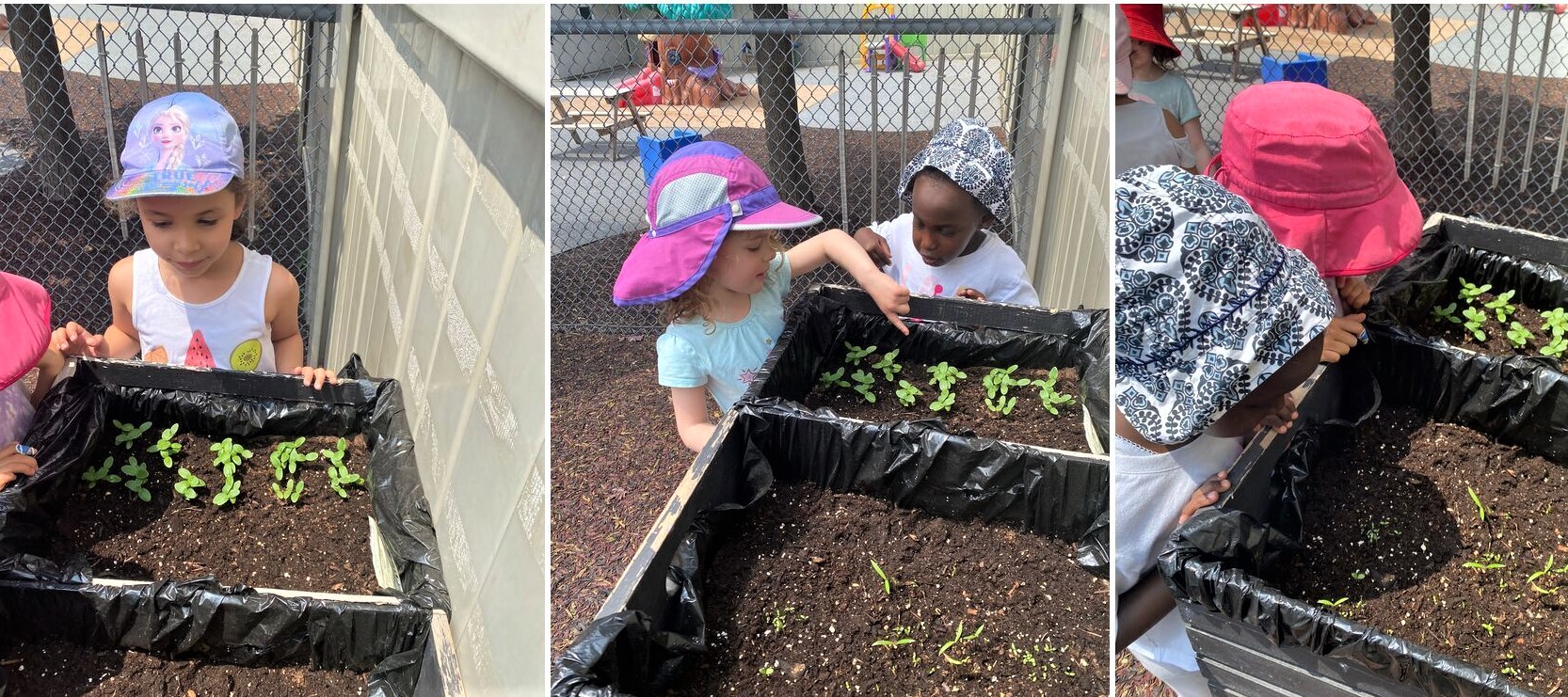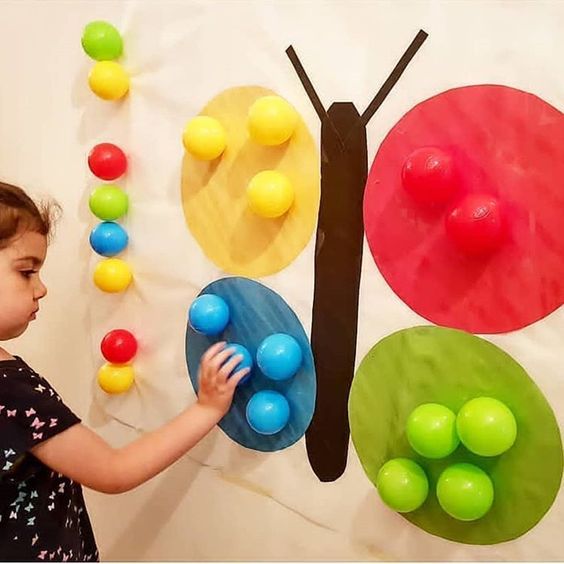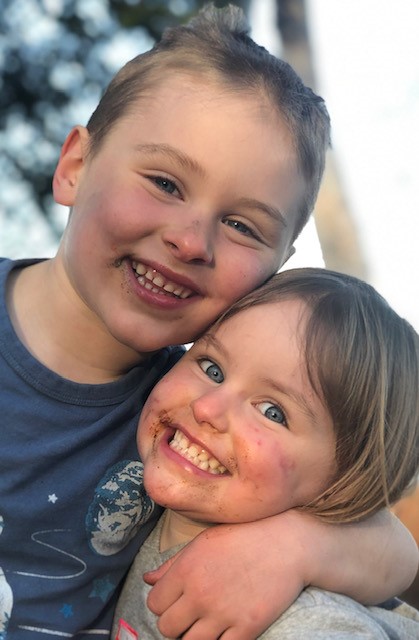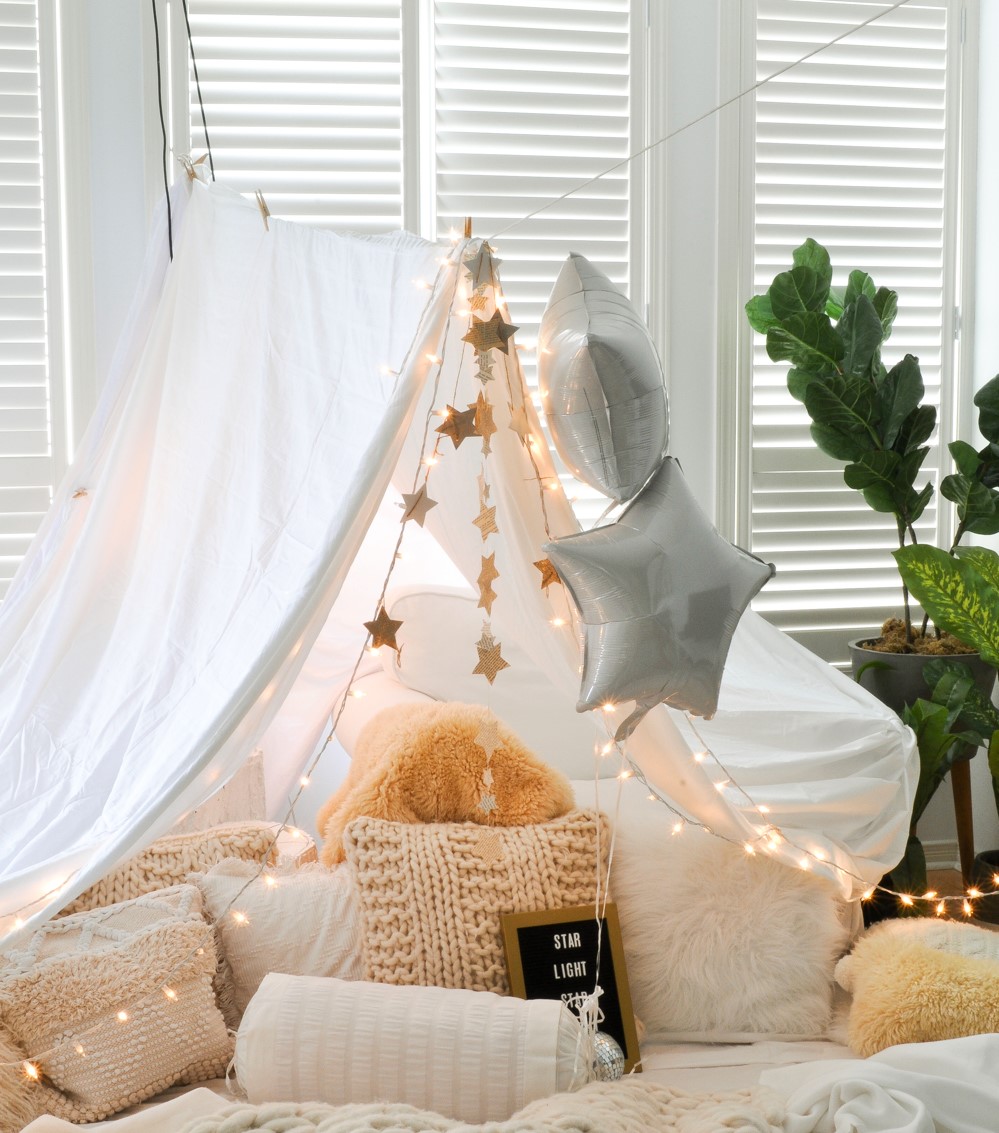4 Pillars Of Learning – Pillar #2 – STEAM (Science)
4 Pillars Of Learning – Pillar #2 – STEAM (Science)
by Susie Beghin, RECE, Founder of Alpha’s Discovery Kids
At Alpha’s Discovery Kids, we aim to create a nurturing, safe space where every child feels they are in their home away from home.
And we know that the first six years of a child’s life are the most formative. These are the years when young brains develop rapidly, and children are like sponges, soaking up information and modelling behaviours from those around them.
That’s why providing the best learning environment possible is at the core of everything we do. We are committed to showing children how to develop the critical skills they need to succeed in life.
With each child’s unique strengths taken into account, we believe in child-initiated and teacher-supported learning experiences that foster their naturally inquisitive nature and cater to their individual needs.
We do this by focusing on our 4 Pillars of Learning: Language & Literacy, STEAM (Science, Technology, Engineering, Art and Math), Physical Activity & Nutrition and Mindful Awareness.
And as you walk through each of our Alpha’s Discovery Kids locations, you’ll experience our award-winning 4 Pillars Of Learning system echoed in each classroom.
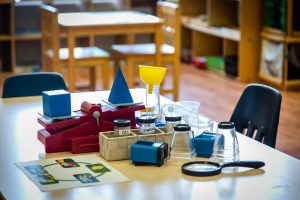
SCIENCE (The first component of STEAM)
We infuse learning in everything we do and believe that the strength of our pillars is in combining learnings from multiple pillars.
Science activities are a fan favourite at Alpha’s Discovery Kids, as it often involves many things to do with nature.
Some of the fun ways we introduce and teach science include:
- Nature walks – a great way of combining physical activity, mindfulness, language and science, nature walks are a fantastic way of sparking children’s natural curiosity. With so many things in nature to see, children can experience a multi-sensory world of wonderment on every trip outside.
- Bringing nature inside – with so many aspects of nature for children to learn, we love bringing nature inside. This can include sensory bins filled with soil, mud painting and exploring the various properties of soil (from dry to wet). Kids also enjoy planting seeds inside pots which stay in the classroom until they are ready to be transplanted outside in the spring.
- Look beyond chemistry – a lot of people associate science with chemistry. And we absolutely enjoy doing some fun chemistry experiments in our classrooms. But there are so many different aspects of science to explore, including astronomy, biology and physics. We dabble in every area of science so that our children can explore the various disciplines of science.
At Alpha’s Discovery Kids, we find that children, in general, are budding explorers, and science is all about exploration and discovery. So we encourage each of our children to understand that as they explore something new in their world, they’re actually little scientists!
As we teach science in our classrooms, it’s done in an age-appropriate manner. For our toddlers, we teach science through several activities, focusing on sensory-oriented activities. We find that toddlers love exploring sensory bins, experimenting with water, how various items float, how sand flows through different sieves and exploring a wide variety of natural materials, including pine cones, soil, leaves, etc.
As we progress through the older ages, kids explore science by creating their own solar system, making their own planets and learning where each is located. We also begin to explore sources of energy, the differences between living and nonliving things, the different types of animals and plants, and their characteristics.
By making science fun, we can tap into a child’s natural desire to learn.
For more information on our 4 Pillars of Learning, or to book a tour, please contact us at https://www.alphasdiscoveryclub.com/contact/ or call us at 905-823-8257.
March Break – 4 ideas for fun-filled family time!
March Break – 4 ideas for fun-filled family time!
by Susie Beghin, RECE, Founder of Alpha’s Discovery Kids
For many families, March Break is a time when they can decompress and spend some quality time together.
But as March Break quickly approaches, many are left wondering what creative things they can do to keep their little ones busy and active during the time off.
Luckily, for those of us who call Ontario home, there are so many magical places to visit, all practically in our backyard! So whether you’re aiming for indoor or outdoor, we’ve rounded up a few fun and family-oriented activities to help get you started.
Anyone up for maple syrup!?
- Maple Town, Milton (Mountsberg – 2259 Milburough Line, Campbellville) – producing maple syrup for over 150 years, this park allows visitors the chance to do guided tours and independent exploration.
- Maple Syrup Festival, Oakville (Bronte Creek Park – 1219 Burloak Drive, Oakville) – an opportunity to enjoy some maple taffy while visiting farm animals and enjoying a guided tour of Maple Lane. This festival also includes a visit to Spruce Lane Farm, where you can learn how to make maple sugar
- Bruce’s Mill – 3291 Soutffville Road, Stouffville – wagon rides, kids activities, demonstrations and pancakes with real maple syrup are what you can expect at this maple syrup trail.
Water anyone?
If you have a budding swimmer in your family but are looking for something different other than your local community pool, you’re in luck. If you’re willing to explore slightly outside of the GTA, your options will definitely expand.
The Niagara Falls area offers several water parks to choose from. So whether you want to make a day trip or stay overnight, you have a few options.
- Great Wolf Lodge is a classic for families, with one of the biggest water parks in Canada offering indoor fun for kids of all ages. From water slides to hot tubs and wave pools, you’re sure to keep busy
- Waves Indoor Waterpark, located in the Americana Conference Resort & Spa, offers over 25,000 sqft of water fun for the family. With day passes available, you have the flexibility to enjoy the pool, toddler splash area and more
- Fallsview Indoor Water Park offers 3 acres of family water fun, with hot springs, an indoor wave pool and day passes available
- Plunge Aquatic Centre is located in Blue Mountain and offers hot tubs, rope swings, waterslides and pool basketball nets. With an indoor splash pad, families of all ages can enjoy the water. And if you’re in the mood to stay more than a day, maybe combining water fun with some outdoor activities, Blue Mountain has many overnight accommodation options available.
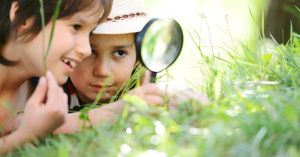
Be at one with nature
Have a child who is in love with nature and animals? March Break is a great time to explore farms, parks and destinations which encourage children’s natural curiosity.
- Bird Kingdom & Butterfly Conservatory, Niagara Falls – 2 different locations with a host of nature-filled fun, kids will get see a variety of feather and winged creatures
- For reptile lovers, Reptilia now has a Whitby location where families can explore at their own pace through the 31,000 sqft of indoor reptile exhibits, including lizards, snakes and crocodiles.
- Royal Botanical Gardens, Burlington, offers families a chance to explore wetland animals, a variety of plants and flowers and self-guided activities exploring the Rock Garden
Just want to veg out indoors?
Those who want to relax at home still have plenty of opportunities to create magical, fun-filled days and evenings.
From finger painting, games, baking, and indoor obstacle courses, to DIY toys and indoor gardens, there are lots of simple activities you can line up during the break.
To encourage imaginative play, another popular activity for kids is indoor camping – all you need is to build your own fort or tent, decorate with lights (optional) and enjoy some campfire snacks, such as smores! Bonus – you won’t need to contend with mosquitos!
Creating your own drive-in movie theatre experience is also a hit with families. Try making your own cars out of boxes – there are a ton of free templates for designing your car online. If you have a projector and screen, it can really help replicate the experience, but a regular TV works just as well. Try adding in some cozy items, like blankets and pillows, and some fun movie snacks, like popcorn, and enjoy!
Enjoy your March Break!
Our Alpha’s Discovery Kids family hopes that you have a fantastic March Break!
Our New Mississauga Location is located at 2632 Liruma Road, Mississauga, ON L5K 1Z1. To book a tour or for more information, please contact us at https://www.alphasdiscoveryclub.com/contact/ or call us at 905-823-8257.

Meal planning for Busy Parents: 5 tips for budget-friendly meals
Meal planning for Busy Parents: 5 tips for budget-friendly meals
As busy parents, it may be difficult to get a nutritious meal on the dinner table each night. And with food costs rising, it may be difficult to do so with a limited budget. I am sure that you have often thought, “What am I going to make for dinner tonight?”. Rest assured, you are not alone. It is possible to feed your family nutritious meals almost every day. Here’s five tips to help you offer nutritious meals for your family on a budget!
-
Plan Ahead
I’m sure you have heard that planning is the key to healthy eating. When we fail to plan, we often choose less nutritious food choices. This doesn’t mean you need to map out each meal and snack for the entire week and stick to it. This approach is probably doomed to fail for most of us. It’s difficult to stick to a rigid meal plan. Instead, try to plan out the week by sketching out a rough meal plan centered around your proteins and think about how you will prepare the meals each week. You can start by choosing to plan the dinners only. Remember to make allowances for your schedule and obligations. For example, if you know that you will be working late one night, you will choose any easy dinner that might include leftovers from a previous meal or something that is simple to make.
-
Shop Wisely
Shopping for food also involves some planning. It’s best to plan out what you will buy before going to the grocery store. To extend your food dollar further, try planning your meals around the weekly sale and promotional items. Use coupons and price matching to purchase items that you need. Purchase off the reduced racks if you can use the items quickly. It will save you money if you check your fridge/freezer/pantry at home prior to shopping. Many times, we buy items that we already have at home because we failed to check what we have. Most importantly, stick to the shopping list and avoid shopping when hungry or emotional. Stay clear of those eye-catching food displays too! This will help you to avoid impulse buying which often adds up at the cash register. Another budget friendly tip is to know how grocery stores place their products. The most expensive items are usually at eye level on the shelf. Try to look above and below eye level for better deals.
-
Choose One Plant-based Protein Meal each week
You will save money by choosing one plant-based protein meal each week such as lentils, beans, or other legumes. These foods are also jam packed with fiber which we all need! Here’s a few great websites with lots of recipe ideas:
-
Make a Balanced Meal
According to the Canada Food Guide, your food plate should have a balance of protein, fruit, veggies, and grains. Fruits and veggies should make up half your plate. The other half is split equally between protein and whole grains. Choose foods that are in season to get the best value for your money and the best nutrition and taste. You can find out when foods are in season in Ontario by visiting https://www.ontario.ca/foodland/page/availability-guide. When you can’t buy items in season, you can choose frozen food options that were picked at the peak of the season.
-
Cook Smart
Having good cooking appliances, utensils and tools will make cooking easier. Invest in good quality appliances that can reduce cooking time or can be used hands-off, such as a slow cooker, instant pot, or air fryer. This will free up your time to do other things. Invest in good utensils and tools that make chopping and slicing easy too! When the cooking process is easy, you will be more motivated to make healthy meals.
You can involve your whole family (even the kids) in the entire process – from planning to shopping to cooking! Teaching about nutrition is one of our Four Pillars of Learning at Alpha’s Discovery Kids. You can find out more about our program and curriculum here.
Gardening With Kids: 7 Lessons They Learn
Gardening With Kids: 7 Lessons They Learn
At Alpha’s Discovery Kids, encouraging growth and development is what we do best. Our students have become very involved in tending to classroom plants. We have made it a seasonal tradition to create an outdoor garden with our preschoolers. They love digging and planting at the beginning of the season, watching the growth and then picking the vegetables during the middle of the season. All the knowledge they gain throughout the process will stay with them for years to come. The learnings will shape them as they grow into adults who will one day be responsible for their own little place in the world. When children help in the garden, they begin to understand what it takes to grow. They begin to understand that plants need water and food just like they do.
7 Lessons children learn from gardening
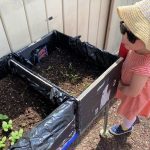 Engages all the senses–Gardening can be a complete sensory experience for kids. Growing plants isn’t about just digging in dirt, although that’s a great way to experience using the touch sense, but kids can use all their other senses while learning how to grow their own food. Sight, taste and smell comes into play when they get to experience the aromas and tastes of what they have harvested.
Engages all the senses–Gardening can be a complete sensory experience for kids. Growing plants isn’t about just digging in dirt, although that’s a great way to experience using the touch sense, but kids can use all their other senses while learning how to grow their own food. Sight, taste and smell comes into play when they get to experience the aromas and tastes of what they have harvested.
Encourages healthy eating–Learning to grow your own food encourages you to eat it. As you and your family eat more and more fruits and vegetables as your garden produces, they may be experiencing new foods for the first time and discovering new favorite foods too.
Life cycles-Big lessons can be learned in the garden about life and the lifecycle of plants, bugs and animals. From new baby rabbits (that you want to keep out) to mature bees carrying honey back to the hive and to the life of the plants themselves, they can literally watch life happen in the garden.
Bugs are useful-Gardening shows kids how useful bugs are in the world. They begin to understand that even earthworms have a place in the circle of life. Learning these things can help make bugs seem less scary.
Nurturing & Responsibility-These two are technically different skills but they really go hand-in-hand. Helping plants grow teaches kids how to nurture a little life and it teaches them responsibility since they will have to help water and feed the plants. Remembering to do this and helping adults keep an eye on the plants is a big responsibility for children. They love to watch as their hard work pays off and the garden vegetables grow.
Family bonding– Gardening is a family experience. Everyone can gets involved on some level. It’s fun for us to do it together and experience growing food or plants. Not only is it fun but it gives us a chance to teach kids so much and that’s fulfilling for us and them.
Gardening is good for the soul-Gardening gives us a chance to pause and get back to nature. Nature has a way of calming us. No screens are involved so that’s a big bonus. It’s a time out from the rest of life when they just get to concentrate on the dirt between their fingers.
Open House – Daycare and Summer Camp 2022
Daycare and Summer Camp Open House 2022
We are so excited to showcase our beautifully expanded and renovated facility in Oakville at our Open House this weekend. We want to give you a little sneak peek of the activities that will be offered for children during this event.
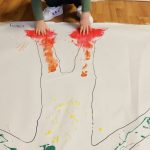
As families wander our hallways, classrooms, and outdoor playground area, they will see featured activities on display as well as engage in some hands-on activities with their children. This will give prospective families an opportunity to experience our Four Pillars of Learning curriculum first hand.
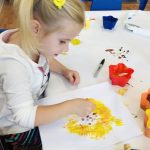
We will be offering some yummy snacks, treats and refreshments to enjoy during this event. We welcome children of all age groups to explore each room and participate in what is being offered along with their parents.
Our program grows with your child and because we know that your families are growing too, we have offerings that begin as early as infants all the way up to 12 years of age.

The founder of Alpha’s Discovery Kids and owner of all three Alpha’s locations, Ms. Susie will be here to meet and greet all guests. Our centre Supervisor Ms. Shannon will also be onsite ready to greet you with a smile, answer questions and offer a personal tour. Our talented team of core educators will be waiting for you in our classrooms ready to represent and showcase our proprietary holistic curriculum.

This event offers a unique opportunity for our existing parents to engage with each other and share their experiences with new families too. Even though we are a well-known award-winning location with a 5-star rating and amazing reviews, nothing beats a real parent to parent chat. We know that education, cleanliness, safety, food and nutrition, love and comfort are the top priorities of all parents. We can’t wait to open our doors and share what we have to offer. With a variety of programs and flexible options, there is sure to be something for everyone.
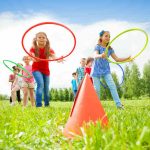
We offer Full-time, Part -time, Toddler, Nursery school, Jr. & Sr Preschool, Kindergarten, Before and After School – Age programs and Summer Camps.


Back to school during a Pandemic: What to expect in 2021
Back to school during a Pandemic: What to expect in 2021
After a warm summer, September has finally rolled around and it’s that time of year when our little ones head back to school or perhaps start attending a new daycare or preschool. We are now 18 months into a pandemic and it’s not over yet! We seem to headed toward a fourth wave here in Ontario which will increase our anxiety levels as we strive to find ways to get back to some kind of normal routine while staying safe.
So, what can you expect for this new school year? Many of the COVID protocols and policies for schools and daycares will continue into the 2021-22 school year. Here’s what to expect:
COVID PROTOCOLS
- Screening – Be prepared for daily screening of your child. Whether your child attends daycare, preschool or any type of school, there will be a requirement for the school to screen the child daily to ensure the child is free from COVID related illness symptoms, has not travelled in the last 14 days and that everyone in their household is also healthy and not exposed to anyone with COVID or COVID symptoms.
- Illness – As cold viruses circulate in the Fall/Winter, be prepared to stay home with your child when they are ill for a few days. Also be prepared to get your child COVID tested if you want them to return to school or daycare quickly. Without testing, your child would need to isolate for 10 days.
- Masks – Masking of children over two years old is still recommended by public health. For children in daycare under 5 years old, masks are not mandatory but still recommended at the parent’s discretion. If your child is between 2-5 years old and attending daycare, you will need to decide if your child will wear a mask or not. Starting in Grade 1, masks are mandatory so ensure your child has a comfortable mask that they can wear for long periods of time.
- Face-to-face communication – Much of the communication between teachers and parents will take place via zoom. In daycares and schools, the use of apps makes it easier to communicate with teachers even though you can’t see them face-to-face on a daily basis.
- Hand Hygiene – Ensure your child knows how to properly wash hands and use hand sanitizer.
In addition to these COVID protocols, there’s the regular back to school preparation as well. Here’s some tips to help you prepare:

Back to school
BACK TO SCHOOL TIPS
- Set safety rules for travelling to and from school: if your child walks or rides the bus to school, talk to them specifically about safety rules. For children in daycare, you may want to discuss parking lot safety and suggest that they need to hold your hand while walking from the parking lot to the daycare entrance.
- Label all clothing and supplies (but not where visible): It’s important to label everything that you bring to school or daycare to avoid it ending up in the lost and found. Remember to label on the inside so that it is not visible to strangers.
- Ask your child open ended questions about their day as part of your pickup routine: find creative ways to talk about it rather than the typical question “How was your day?” which normally doesn’t give you much info. Make sure your child understands that it’s okay for them to talk to you and their teacher about their needs or concerns.
- Role play: talk to your child about the new teacher/school/daycare and make it positive. If you are anxious about anything, they will pick up on that and it will cause them anxiety too! You can also role play different situations that may come up at school or daycare such as dealing with conflicts.
I am sure that for most of us, the first few weeks following back to school can be a little crazy. Remember to breathe, take time for yourself and enjoy the moment! Before you know it, your kids will be all grown up!
Especially in the younger years, our children will look to us for reassurance about daycare and school more than we think they will. While a cautious parent is a good parent, a wise parent will take great care to monitor the messages that they are sending to their child. If you start early by teaching your child how to stay safe and lay some ground rules, then you are off to a great start with preparing your child for life in the real world.
For more information about COVID protocols in the upcoming school year in Ontario, Visit https://www.ontario.ca/page/covid-19-health-and-safety-measures-schools
For more information about Alpha’s Kindergarten program, click here.
Water Safety Tips
Water Safety Tips
Water safety is an important topic that we must educate ourselves about as parents. Knowing how to be safe in and around water is one way to keep your family safe. While water safety is somewhat of an unpleasant topic, it continues to be an important one. Even if you think you already know everything about water safety, take a moment to review these educational tips. I few minutes of reading may help to save a life. Knowing the risks is the key to preventing injuries and or death.
Children are naturally drawn to water and quickly discover the fun of splashing in it. Sensory play especially with water should be encouraged but ensuring that this is done safely is essential. You can never be too careful when it comes to water safety whether you are inside or out.
Close attention needs to be placed on safety around water to prevent drowning, scalding or electrocution. Regardless of your child’s age – whether infant, toddler preschoolers, school age or if you have young, curious, or even clumsy pets, it’s important to know that the number one safety tip is Supervision.
Here is why …. Did you know that babies can drown in as little as just 1 or 2 inches of water? It can happen silently, and within seconds, especially infants, because they don’t have much neck and muscle control.
Remember: Never leave your child alone or in the care of another young child in or near water—not even for a moment.
Most child drownings inside the home occur in bathtubs, and more than half of bathtub deaths involve children under 1 year of age.
Here are a few simple safe water tips to live by and share with anyone who cares for your child.
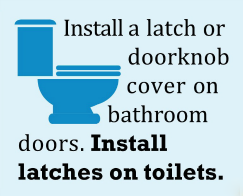
Bathroom water safety tips:
- Put toilet lids down. Install safety latches or locks on all toilet seat lids to keep curious little fingers from lifting them.
- Pull the plug on the tub. Consider removing the bathtub drain plug when it’s not in use to avoid the tub filling if a child turns on the faucet.
- Keep the bathroom door closed. As an added layer of safety, use safety latches or doorknob covers to keep bathrooms closed.
- Check the water temperature. Before putting your baby in the bath, check the water temperature with your wrist or elbow. Tap water that’s too hot can quickly cause burns serious enough to require a hospital visit or even surgery. In fact, hot water scalding is the top cause of burns among babies and young children.
- The hottest temperature at the faucet should be no more than 120 degrees Fahrenheit to help avoid scald burns. In many cases you can adjust your water setting to not go above this temperature.
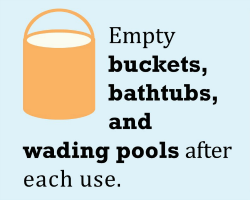 Outdoor water safety:
Outdoor water safety:
- Never leave a filled, open-top water container unattended. Whenever they’re not in use, be sure to completely empty any liquids in containers such as:
- buckets and pails used for cleaning or painting
- wading pools
- coolers with melted ice
- large water bowls for pets
- trash cans or recycling bins that may collect rainwater
- secure swimming pools, including large, inflatable above-ground pools and other temporary pools, should be surrounded by a fence on all 4 sides.
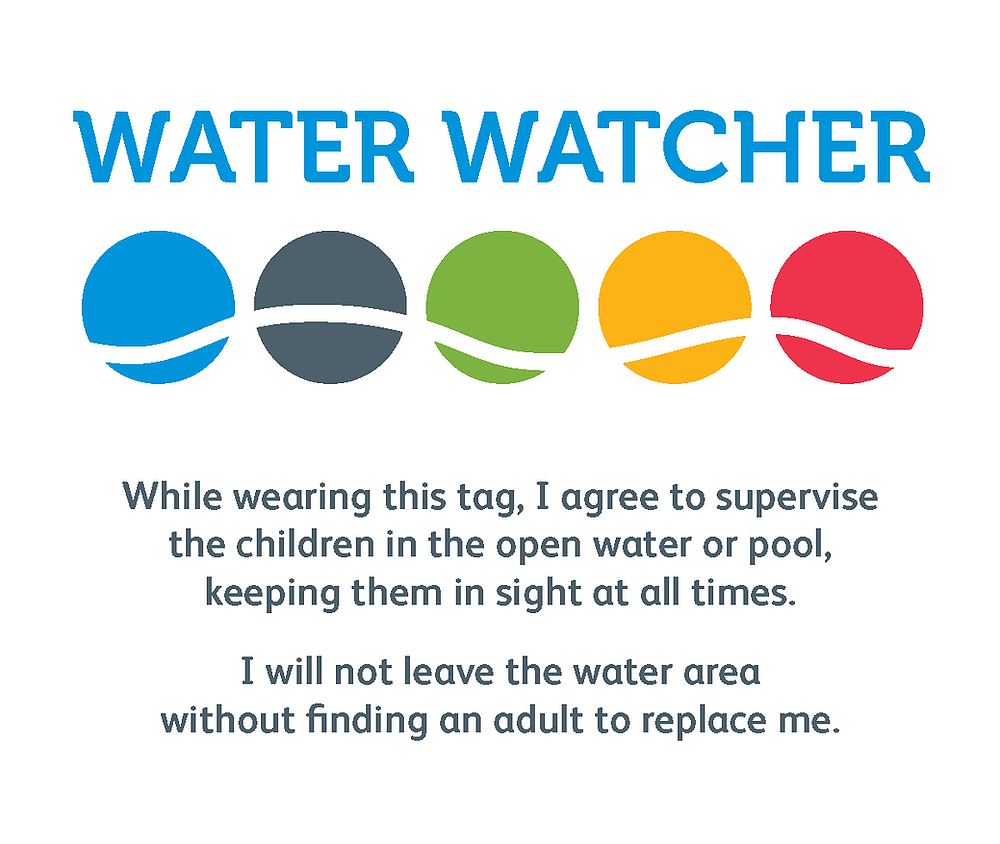 Pools:
Pools:
- Assign a qualified Adult or youth with life saving certificate to supervise children
- Ensure life jackets and flotation devices are used with supervision
- Ensure Life preservers are readily available
- Use a water watcher sign. Assign a “water watcher” to supervise at all times and ensure they know their responsibility.
- Pool fences should: be at least 4 feet high and have no opening under it or between slats more than 4 inches wide.
- Check the gate frequently to be sure it works and keep it always locked.
- Keep toys out of the pool area when not in use so that children are not tempted to try to get through the fence.
- Be sure to always cover and lock hot tubs and spas right after using them.
Use touch supervision
- Have a towel within reach so you can always keep a hand on your baby so that you are within arms reach at all times.
- Before your baby begins to crawl or walk, check your home and surrounding area for any other potential water dangers.
![]()
Water and electricity don’t mix
- Be sure to keep electrical cords, battery powered devices and other power sources away from water and out of the reach of children.
It’s important that you teach your children water safety!
- Teach children the guidelines, rules, and boundaries around water that they will understand and follow.
- HAVE FUN AND PLAY SAFE!
Mindful Mud – An Essential Play Experience!
Mindful Mud – An Essential Play Experience!
While the idea of getting messy to some may be unappealing, especially a parent or caregiver that has to clean up the mess! For those that may be skeptical, consider all the benefits of playing in the dirt.
The earthy goodness of mud gives our kids an opportunity to engage in messy play, practice mindfulness and connect with nature. Think of a time when you made a sandcastle and suddenly lost track of an hour. That was you, feeling the effects of mycobacterium vacate. This is a big word for the microscopic bacteria in dirt that increases the serotonin level in our brains, making us feel happy and relaxed.
Our young technologically savvy generation of kids are just not getting enough time to play outside – especially with online learning and technological distractions. While you can simulate many experiences virtually these days, playing in the dirt is not on that list.
Have you ever noticed that children who play outside laugh more? And laughter leads to feeling good! Kids who play outside also grow in their character development: they become more adventurous, more self-motivated, and they are better able to understand and assess risk.
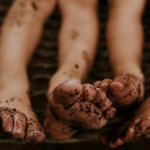
THE SCIENCE OF MUD
- MUD INCREASES BRAIN ACTIVITY– When children play with mud they use all of their senses, resulting in a highly stimulated and active brain.
- MUD INCREASES PHYSICAL ACTIVITY-When children play outdoors, and in mud, the incidental movement and physical activity increases, helping children maintain a healthy lifestyle and develop their physical literacy.
- MUD REDUCES ALLERGIES & ASTHMA SYMPTOMS -Dirt is also great for the immune system, especially in children. Research has shown that early exposure to naturally occurring microbes in soil will help build stronger, more disease-resistant kids.
- MUD PLAY BUILDS CREATIVITY – The open-ended nature of mud play is perfect for the developing brain. There is no end to the creations, ideas and games children will invent. During this type of unstructured, outdoor play, children are not only exercising but are building their ability to form ideas, problem solve, and think critically, as well as be innovative and inventive.
Here are some ideas for your children:
- If you want to control the mess a bit or have limited space, try a mud kitchen !
- Give your child a bucket and a shovel and set them in the dirt. See what happens.
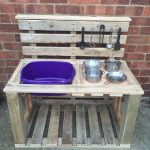
If you really want to control the mess, you can also create a DIY mud sensory bin. Check out our blog on how to create DIY sensory bins.
BabySafe Project – Pregnancy and Wireless Radiation
BabySafe Project – Pregnancy and Wireless Radiation
Have you head of the Babysafe Project? I recently became aware of this project which addresses a very serious issue affecting our future generations of children. What is the impact of widely used wireless technology on the unborn?
I have always been in awe of the process by which humans come into existence. From a single cell to a growing fetus to a baby born into this world full of life! Many women who learn that they are pregnant start to eat differently, take care of themselves and feel a strong sense of responsibility for this new life inside them.
Over time, we have learned more about environmental impacts to children within the womb. From the food you eat to the water you drink to even the air you breathe can all have an impact to that new life growing inside you. It may seem overwhelming but knowing the risks and things you can do to reduce harmful exposures is within your control.
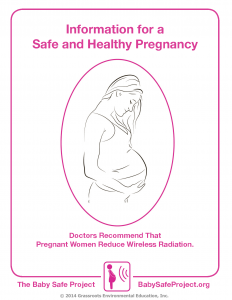
The Babysafe project focuses on one key environmental influence – wireless radiation. They point to scientific research that indicates that wireless radiation exposure can be harmful – even carcinogenic – to your baby and therefore should be avoided or reduced. Visit www.babysafeproject.org to learn more about the science and research and the effects of wireless radiation on both you and your child.
So, what can you do to reduce or eliminate your wireless radiation exposure risk? First and foremost, is awareness of the issue. Spread awareness to everyone you know about the risks and steps you can take to protect yourselves and your little ones.
Here’s some simple steps to reduce exposure to wireless radiation:
1) Do not carry your cell phone on your body – not in your bra or pocket
2) Don’t hold the cell phone, tablet or other wireless electronic device against your abdomen
3) Avoid cordless phones – especially in your bedroom – phones with a cord don’t emit radiation!
4) Streaming results in higher levels of radiation exposure – try to download and then use it in “Airplane mode”
5) Use connected wired devices for your computers instead of wireless
6) Unplug your WiFi router at home when not in use (e.g. at bedtime)
We’re fortunate to have two locally-based national not-for-profit organizations that collaborate with The BabySafe Project in raising awareness about the Project. Canadians For Safe Technology (C4ST) is based in Oakville, online at c4st.org. Electromagnetic Pollution Illnesses Canada Foundation (EPIC) is based in southwest Etobicoke, online at iexistworld.org. These organizations welcome questions, have a wide variety of resources (electronic and printed materials), and meet online with parent groups who want to learn more.
More resources:
In this video, women talk about how they reduce their risk.
Lockdown Staycation Ideas – Indoor Camping!
Lockdown Staycation Ideas
5 Easy Steps to a low cost and low mess indoor camping experience
Thinking up ideas for a staycation is more challenging then ever with lockdown and stay at home orders in place. Planning ahead can be difficult with the uncertainties of the pandemic. We all look forward to long weekends. In Canada, May 24th is a holiday in honour of Queen Victoria’s birthday and is considered the first long weekend to kick off the summer season. For many Canadians, it means the beginning of camping season, gardening and local festivals, concerts, outdoor markets and picnics. While we can still enjoy some of these outdoor activities, the options are limited by the restrictions of the pandemic. Here’s a staycation idea that actually works really well during a pandemic.
Have you every tried camping in your own home?
Chances are that there is more then one of you out there thinking that even camping in your backyard sounds like a task you are simply not up for.
What if I told you that you are not the only one? It doesn’t have to be difficult. And it can be a lot of fun for both you and your kids!
What if I told you can now camp with the kids, with no packing, no driving, no paying for campsite rental, no bugs, no questionable bathrooms, and you can sleep in your own bed?
This is an opportunity to glam it up with your own style and it will certainly be a post-worthy experience to share – Don’t forget to tag us.
Here’s 5 Easy Steps to create that perfect at-home indoor camping experience!
- FORT – Set it up!

No camping experience is complete without a tent. Depending on the age of your children, you can choose to make this an all-hands-on deck project with the children helping set up your camp site or you can make it a surprise. This can be your child’s bedroom, basement or living room area. Notice I am not mentioning outside 😉!
Make it -check out these links for tents you can create with minimal supplies or talent.
https://www.artbarblog.com/easy-forts/
http://www.thriftyandchic.com/2016/01/diy-4-sided-drop-cloth-teepee-for-20.html
Add mini lights & decorations for a pitch-er perfect tent!
2. FOILAGE
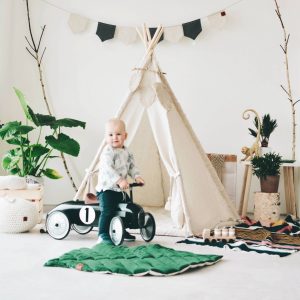
Bring the outdoors in! This is really just an extra little thing you can do to bring the outdoors in and enhance the camping experience.
You can gather Outdoor items, stones, logs, branches, indoor or outdoor plants to place around the “campsite” or even setup an artificial tree.
3. FIRE-Spark it up
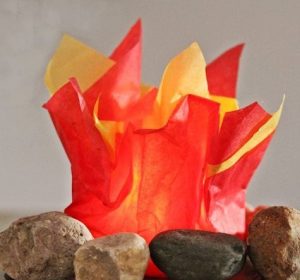
One of the best parts of camping is the bonfire! A bonfire is the perfect place to gather round and sing a campfire song, or tell funny stories. It’s also a great place to read books.
Make it- click on this link for an easy way to build a crafty campfire.
http://aboutfamilycrafts.com/how-to-build-a-campfire/
4. Food- Feed the fam!
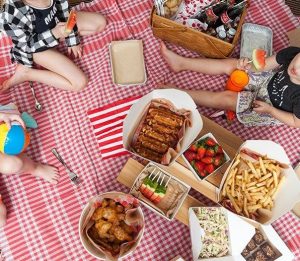
If you don’t have a fireplace to roast marshmallows the next best thing to the campfire is a BBQ. Grill some hamburgers, hot dogs, corn or make simple PB&J sandwiches. You can even roast marshmallows by holding a stick above the heat of the BBQ grill.
Whatever you decide to do – Keep it simple!
Here are 3 S’more options to enhance your camping staycation
Make it-Microwave Smores- https://shelfcooking.com/smores-recipe/
Smore snack bag- https://ziploc.com/en/Recipes/Sweets-And-Desserts/S-Mores-Mix
Make sure you take a nice walk after those sugary smores and tire out those kiddo’s so everyone gets a good night sleep including Mom & Dad!
5. FUN!

Last but not least, Have Fun!!!
Hopefully by now the kids are tuckered out and ready to retire to their sleeping bags. Before they do, make it dark, turn on those string lights, lamps and flashlights and play with the shadows. Add in some soothing nature sounds and soothing music too!
You can even make your own stars on the ceiling with a flashlight! Just cover the flashlight with black paper and cut out the stars.

More ideas to add to your indoor camping experience:
Read some camp related stories
https://www.pre-kpages.com/books-camping-preschool/
Shadow puppets
https://whereimaginationgrows.com/exploring-light-with-shadow-puppet-play/
Starry sky flashlight
https://happyhourprojects.com/make-a-starry-night/
To learn more about Alpha’s Discovery Kids Programs, click here!


